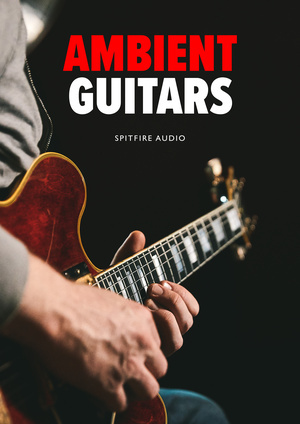New Software Review: Ambient Guitars by Spitfire Audio

Spitfire implements their powerful eDNA engine and Evo Grid into the re-imagined “Ambient Guitars” collection.
Leo Abrahams is a renowned guitarist who has toured with artists including Imogen Heap, Roxy Music, Grace Jones, and Pulp. He has composed scores for movies such as The Lovely Bones (with Brian Eno) and Hunger (with David Holmes), and is credited as the guitarist on film scores such as ’71, Ocean’s 12 and Ocean’s 8, Twilight, Green Zone, Molly’s Game, and The Man from U.N.C.L.E.
Spitfire Audio, leaders in sample library development, have collaborated with Abrahams on multiple libraries in the past. These have now been re-released as Ambient Guitars, a sonic toolkit of cinematic guitar sounds, textures, and loops. Let’s see what this newly rebranded collection all about.
Features
Ambient Guitars takes both of Spitfire’s Enigma 1 + 2 libraries and combines them, while adding 10GB of brand new material and 160 new artist presets to the package. It is available in Native Instruments’ Kontakt sample engine, which is compatible with the AAX, VST 2, VST 3, and Audio Unit standards.
Sounds in Ambient Guitars are organized in 10 banks: Inspiration, Distorted, Inspiration Distorted, Enigmatic Pads, Amped Guitar Pads, Feedback Evogrid, Arps n Chords, Odd Loopers, Atonal, and Artist Presets.
Within Ambient Guitars you will find a plethora of different sounds, ranging from those made by rubbing coins on guitar strings to more sophisticated and heavily-processed meditative pad material. In need of long, evolving textures of distorted guitars feeding back? That’s available here too. The library was made mostly using a Trussart guitar, as well as a 1960s Gibson 355, Gibson SG, and a Danelectro Hornet.
As most of the presets in Ambient Guitars use Spitfire’s proprietary eDNA engine, I’ll start with a basic description of how that works. eDNA instruments are made up of two sounds loaded into either of two sound bays: A and B. The sounds then go through a “wobbles” section, and then into a more traditional filter and envelope, which are independent for each sound bay. There’s a mixer that will allow you to blend between the two bays, and then the mixed signal is sent into a gate sequencer that you can use to make everything from techno rhythms to simple gated tremolo effects. Finally, there’s an FX section at the bottom which can be used to further mangle the sound.
In Use
As a guitarist, I’m typically skeptical of “software guitars”. However, unlike Scarbee, The Odin, and the impressive MusicLab Real Guitar series, Spitfire actually doesn’t aim to give you a plethora of real guitar articulations and key-switchable funky strumming patterns—after all, this library is called Ambient Guitars. Instead, Spitfire has created a really cool library for adding guitar-like textures and organic warped sounds into your productions.
The Feedback Evo Grid alone justifies the $299 price point of this library. As discussed in some of my previous Spitfire reviews, the Evo Grid interface allows you to combine multiple differing articulations to create evolving soundscapes. The “Taking the Chaos into Ambience” Evos along with “Lunarscapes” quickly created a very inspiring wall of sound full of character and movement. The 16 x 16 Evo Grid offers four different amps and signal paths to patch in and mix, allowing you to add crucial variation to your composition and make it feel more “real”.
To reiterate, Ambient Guitars isn’t your typical guitar VI. In fact, the “normal” plucked and strummed single notes and power chords found in the “Distorted” presets folder are some of my least favorite patches in the library. The range of distorted chaos to mutilated plucks and reflective pads is what makes this library stand out, and I can’t think of any other collection that competes. The new Christian Henson presets were particularly impressive, showcasing everything from disgustingly gritty synthetic bass pads and sludgy textures to sweet and aromatic sounds.
Check out Ambient Guitars in action here:
To download the full resolution audio files, click here.
To Be Critical
I found the presets in the Ambient Guitars’ Distorted category to be a little bland. Power chords and single notes can be found in most other guitar libraries, and the ones here didn’t seem to stand out from the plethora of others available online.
Additionally, presets like Sag Aloo felt a bit lacking and unnecessary for a product that is focused on ambient music and textures. Conversely, I really enjoyed using the eDNA engine sounds and found presets like “Lonely Existence of a Mars Rover” way more usable and overall just cooler.
Sometimes too many presets can be a turnoff, and I found a lot of sounds in Ambient Guitars to be very similar to one another. This holds true especially in the Distorted category, where pluck presets sound like they have differing levels of distortion—but even besides that, there aren’t too many distinctions between them. And while Ambient Guitars does provide NKS support for easy preset navigation, the sheer number of sounds can be a bit daunting when you’re just trying to get to work quickly. That said, this could also be a matter of personal taste as some people may love having so many sounds accessible right at their fingertips.
Summing it Up
Spitfire Audio’s Ambient Guitars is sure to be a valuable addition to the toolkit of many film and TV composers, as well as composers of ambient styles of music. You can feel Leo Abrahams’ unique voice in every single patch in the library, providing your compositions with a layer of emotion that is simply lacking in most other guitar libraries.
The fact that Spitfire has re-imagined these pre-existing libraries proves that they are attentive to the needs and wants of their dedicated user base. Ambient Guitars takes advantage of Spitfire’s incredible eDNA engine and Evo Grid interfaces, adding crucial functionality to an already great selection of guitar sounds. I wonder why the company didn’t make Ambient Guitars into a dedicated plugin as they did for some of their newer libraries, but I’m very happy with it staying within the Kontakt platform—I hope Spitfire continues to do this moving forward.
Please note: When you buy products through links on this page, we may earn an affiliate commission.








[…] Leo Abrahams is a renowned guitarist who has toured with artists including Imogen Heap, Roxy Music, Grace Jones, and Pulp. He has composed scores for movies such as The Lovely Bones (with Brian Eno) and Hunger (with David Holmes), and is credited as the guitarist on film scores such as Read more… […]